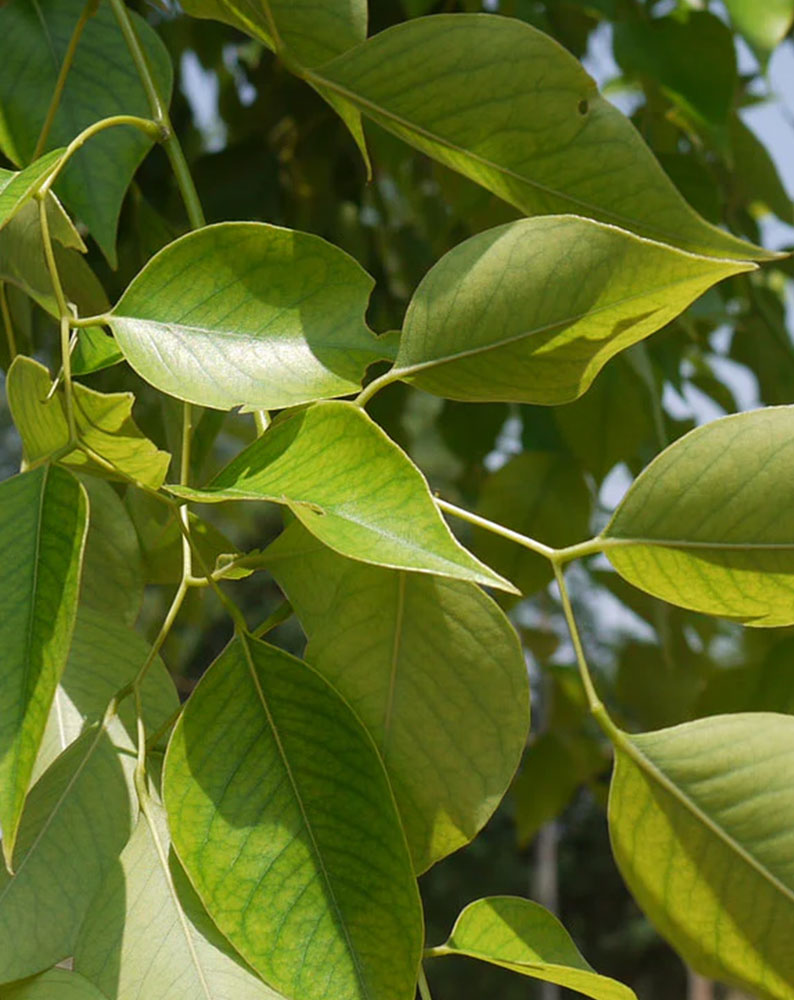Sheesham (Dalbergia sissoo)
- Family: Fabaceae
- Local Names: Arabic (dalbergia,sissoo), Bengali (shisu,shishu,sisu), English (Bombay blackwood,sissoo,Indian rosewood,sisso), Hindi (agaru,biridi,tali,gette,kara,shisham,sisam,sissai,sissu,sissoo), Indonesian (pradu-khaek,du-khaek), Javanese (sonowaseso)
Description
1. The Indian Rosewood is a deciduous tree that grows upright. It can reach a height of 25 metres and a diameter of 2 to 3 metres. It has up to 15 cm long, leathery leaves. The blossoms are a light shade of pink. It has an oval-shaped crown. Brown in colour and shaped like a pod, its fruit is firm and dry.
2. Sheesham wood has deeper streaks that range in colour from golden brown to dark brown or chestnut, giving it a rich and lustrous appearance. The wood is solid and tough, with an apparent immediate grain that may also be interlocked. It has a medium to coarse texture and a herbal shine. The heartwood is golden to dark brown, while the sapwood is white to pale brown in colour.
Ecology
Abundant moisture and lack of competition are the key to its successful regeneration; it is therefore found in riverine environments where sunlight and moisture are plentiful. Associated with Pinus roxburghii, Acacia catechu and Shorea robusta. D. sissoo is adapted to a seasonal monsoon climate and a dry season of up to 6 months.
Native range
Afghanistan, Bangladesh, Bhutan, India, Malaysia, Pakistan
Tree Management
A fast-growing species; growth rates of 3.7 m in 1 year, 5 m in 3 years, 11 m in 5 years and 15 m in 10 years have been recorded. Dalbergia sissoo plantations are established in block or strip plantations at 1.8 x 1.8 m to 4 x 4 m. Closer spacing is used for straight timber of good quality. When the canopy closes, at about 6 years, 30-40% of the stems are thinned to selectively remove suppressed, diseased and badly formed trees. Thinning is recommended every 10 years where the rotation is 30-60 years. There is evidence that the stumps begin to lose vigour after 2 or 3 rotations when managed as a coppice crop. It coppices vigorously up to about 20 years of age.
Seed storage behaviour is orthodox; viability is maintained for 4 years in hermetic storage and 1-2 years when stored in airtight containers under dry, cool (5-22 deg. C) conditions. There are approximately 45 000-55 000 seeds/kg.
Abundant moisture and lack of competition are the key to its successful regeneration; it is therefore found in riverine environments where sunlight and moisture are plentiful. Associated with Pinus roxburghii, Acacia catechu and Shorea robusta. D. sissoo is adapted to a seasonal monsoon climate and a dry season of up to 6 months.
While seeds may be sown without pretreatment, it is recommended that they be soaked in water at room temperature for 24-48 hr, inoculated with Rhizobium after soaking and sown immediately. D. sissoo rarely regenerates under the parent canopy. Natural regeneration is nonetheless abundant along streams and riverbanks where the pods have been carried by floods. Ripe pods may be collected manually by climbing trees and picking the fruits or by shaking the branches and picking the fruits from the ground. Propagation by root suckers is done best by cutting stems just below the soil surface. While it is difficult to propagate using stem and branch cuttings without hormone treatments, exogenous application of auxins (IAA, IBA and NAA) have been found to improve survival and growth rates.
Timber
Dalbergia sissoo is one of the most useful timber species of India. The heartwood is very hard and close grained with a specific gravity of 0.62-0.82. It seasons well and does not warp or split; it is extremely durable and is one of the timbers least susceptible to dry-wood termites in India. Wood offers resistance to sawing and cutting but is excellent for turnery, takes a good polish and finishes to a smooth surface. It is used for high-quality furniture, cabinets, decorative veneer, marine and aircraft grade plywood, ornamental turnery, carving, engraving, tool handles and sporting goods. Its root wood is used for tobacco pipes. In village industry, D. sissoo is popular for doors and windows.
Shade or Shelter
Used as a windbreak in mango, coffee and tea plantations. These shade-loving crops also benefit from improved soil fertility under D. sissoo.
Medicine
Oil obtained from the seeds is used to cure skin diseases. The powdered wood, applied externally as a paste, is reportedly used to treat leprosy and skin diseases. The roots contain tectoridin, which is used medicinally.
Gum or Resin
The bark yields a gum of inferior quality.


